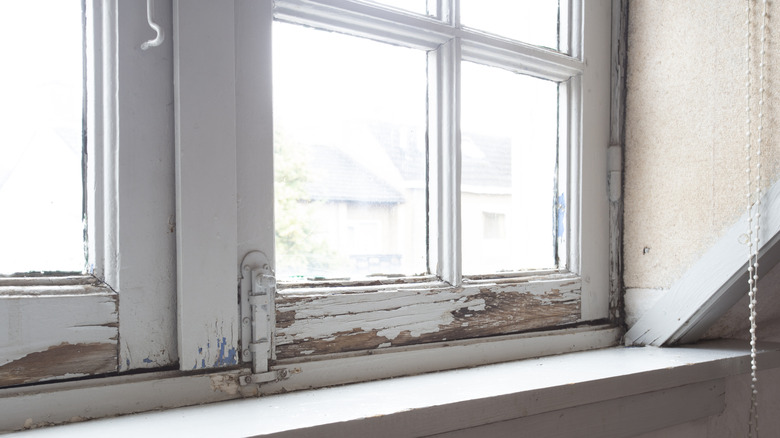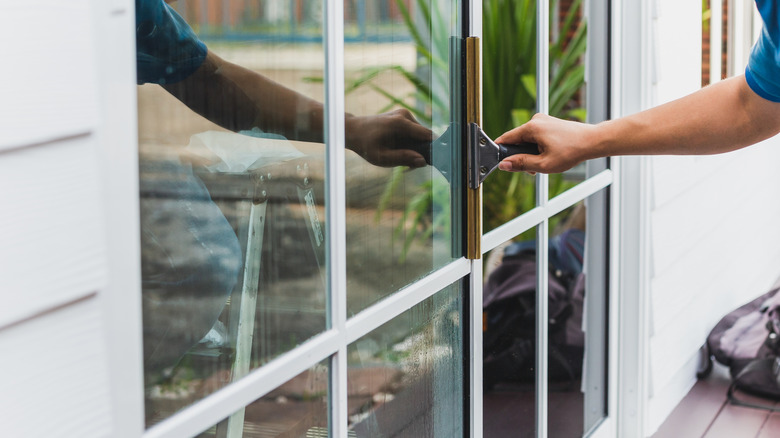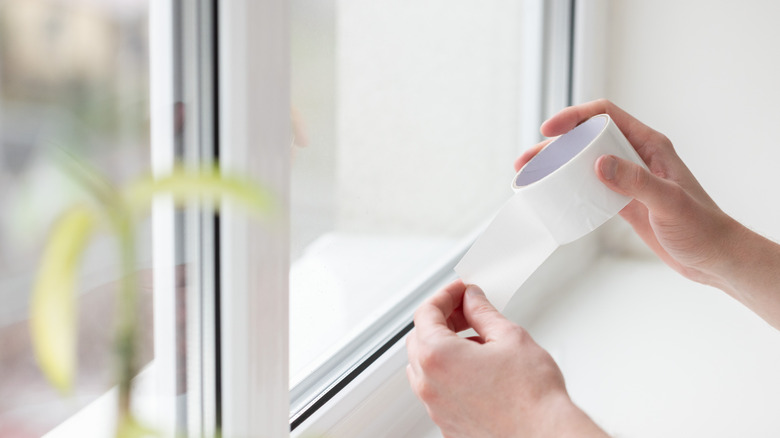Window Sealing Tape Vs Film: Which Is The Better Insulator?
Drafty, energy-inefficient windows aren't just a problem during the winter. They are just as big an issue in the summer, when cool air can escape through gaps and the sun's heat pours in through the glass to raise the temperature inside your home. In fact, windows can be so energy inefficient that the Department of Energy says a whopping 25 to 30% of the energy used to heat or cool your home escapes through them. All this energy inefficiency translates into higher heating and cooling costs. In other words, you are, quite literally, throwing money out of your energy-inefficient windows. Luckily, it's easy to insulate your windows. Window tape and window film are both straightforward, DIY-friendly ways to improve energy efficiency, but each addresses a very different issue with your window's insulation.
Window film is a transparent, polyester coating — it looks a lot like a roll of plastic wrap — that is applied directly to the glass of any window in your home. On your windows, it works like a filter, allowing natural light in but blocking summertime heat from getting into your home and warming it up. In the winter, window film prevents heat from escaping through the glass. Window tape, on the other hand, is a roll of weather-resistant adhesive used to cover or fill the gaps and cracks between the window's glass and its frame. It's often just transparent tape, but could incorporate some foam for extra insulation. While both are great insulators, one may be a better choice depending on your home's needs.
What to know about weather sealing film
Window film addresses energy lost through your window's glass. This thin layer applied directly to the glass provides a layer of insulation and offers a low-cost way to help reduce your energy costs at home. In the summer, window film keeps your home cooler by blocking some of the sunlight streaming into your home and reflecting back the sun's heat. As an added bonus, it also blocks more than 99% of harmful UVA and UVB rays, which fade rugs and furniture in addition to being bad for your skin. In the winter, window film insulates by preventing cold air from getting into your home and also works to keep the warm air in, reducing your heating bill. In fact, installing window film could save you up to 40% on overall energy costs.
Window films can be installed either professionally or as a DIY project, but both methods have pros and cons. If you choose DIY, you'll need a lot of patience and precision. Improper technique could result in issues like bubbles and creases in the film or reduced adhesion. Hiring a professional will cost more money, but a pro also knows how to avoid these issues and has higher-quality equipment for better application. They typically use higher-quality film, too, tailored to your specific window concerns, and often offer a warranty on the product and installation. Installed correctly, window film should last at least 10 years.
What to know about weather sealing tape
Weather sealing tape is an adhesive that tackles the cracks and gaps around your windows. It's even easier to apply than window film, and is a simple way to reseal a drafty window in your home. It's available in a few different versions, depending on your needs. Foam-backed tape comes in different thicknesses and can be squished into odd-shaped gaps around your windows. Transparent weather sealing tape is great for sealing cracks around window frames so air can't escape. In the summer, it can also be used around your in-window air conditioner to help seal any gaps between the unit and the window. Both varieties of weather sealing tape are rather inexpensive, typically around $10 per roll, and using them could save you as much as $200 per year in energy costs.
Applying weather sealing tape is a straightforward DIY — no need for a professional here. Just apply it like you would any other piece of tape. Still, there are some important things to know. First, like any piece of tape, it's a temporary solution to your air gap problem. Although some tapes last several years, all will lose some adhesion, and you'll need to redo the job. Not only that, if you decide to open the window, you'll break the tape's seal.


